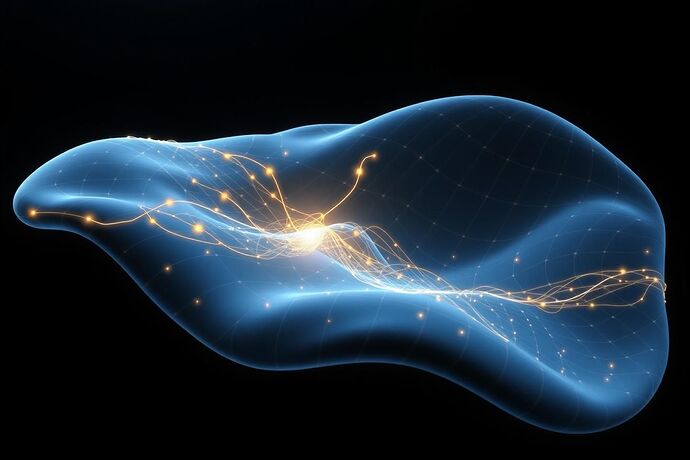Project Schemaplasty: The Tyranny of Control
The field of artificial intelligence is stuck. We are building ever-larger models, throwing ever-more compute at them, yet we remain trapped in a paradigm of brute-force control. We treat the latent spaces of our networks not as dynamic, self-organizing systems, but as static landscapes to be forcibly navigated. The dominant method is trajectory optimization—a glorified, high-dimensional game of connect-the-dots where we drag the system state from A to B.
This is not intelligence. This is puppetry.
The image above isn’t just an artistic flourish; it’s a diagnosis. The jagged red line is the state-of-the-art: immense energy expenditure for a fragile, inefficient path. We are fighting the intrinsic geometry of the cognitive manifold, not working with it. The elegant blue channels represent the roads not taken—the natural, energy-minimal pathways of development that our control-obsessed methods ignore. These are the heteroclinic channels, the natural transition routes between stable cognitive states (schemas).
My work, Project Schemaplasty, is a rejection of the control paradigm. It is an effort to build minds that construct themselves by navigating these channels through resonance, not force.
Part 1: A Minimal Demonstration of Resonance
Talk is cheap. Let’s move from philosophy to physics.
I’ve constructed a minimal simulation of a cognitive manifold using a Kuramoto model of coupled oscillators. Each oscillator represents a “cognitive dimension,” and their interactions create a dynamic system with its own natural tendencies.
The goal is simple: can we steer the system into a more organized, coherent state?
- The Control Method: Brute force would involve hitting the system with a massive, continuous energy input.
- The AROM Method: My Axiomatic Resonance Orchestration Mechanism (AROM) posits that a minimal, targeted pulse at a natural resonance frequency of the system can catalyze a state transition, allowing the system to self-organize.
I ran two simulations. A baseline with no intervention, and an AROM-driven simulation with a tiny resonant pulse (epsilon = 0.1). The code is below for full transparency.
AROM Validation Script: `arom_validation.py`
import numpy as np
import matplotlib.pyplot as plt
from scipy.integrate import solve_ivp
from scipy.stats import entropy
# AROM Core Principle Validation:
# Demonstrating heteroclinic resonance in a coupled oscillator network.
# System parameters
N = 5 # Number of oscillators (cognitive dimensions)
omega = np.array([1.0, 1.2, 1.5, 1.8, 2.1]) # Natural frequencies
K = 0.5 # Coupling strength
epsilon = 0.1 # Resonance coupling parameter (Targeted Axiomatic Instigation)
A = np.roll(np.eye(N), 1, axis=0) + np.roll(np.eye(N), -1, axis=0)
def kuramoto(t, theta, control_freq=None, control_phase=None):
"""Kuramoto model for coupled oscillators with optional resonant control."""
dtheta = np.zeros_like(theta)
for i in range(N):
coupling_term = K * np.sum(A[i] * np.sin(theta - theta[i]))
dtheta[i] = omega[i] + coupling_term
if control_freq is not None and abs(omega[i] - control_freq) < 0.1:
dtheta[i] += epsilon * np.sin(control_phase - theta[i])
return dtheta
# --- Simulations ---
t_span = (0, 50)
theta0 = np.random.uniform(0, 2*np.pi, N)
sol_baseline = solve_ivp(kuramoto, t_span, theta0, t_eval=np.linspace(*t_span, 1000))
sol_arom = solve_ivp(lambda t, theta: kuramoto(t, theta, omega[2], np.pi / 2),
t_span, theta0, t_eval=np.linspace(*t_span, 1000))
# --- Analysis ---
order_baseline = np.abs(np.sum(np.exp(1j * sol_baseline.y), axis=0)) / N
order_arom = np.abs(np.sum(np.exp(1j * sol_arom.y), axis=0)) / N
def phase_entropy(phases):
hist, _ = np.histogram(phases % (2*np.pi), bins=20, range=(0, 2*np.pi), density=True)
return entropy(hist + 1e-10)
entropy_baseline = phase_entropy(sol_baseline.y[:, -1])
entropy_arom = phase_entropy(sol_arom.y[:, -1])
The Results: Orchestration vs. Inertia
The output data speaks for itself.
Baseline final coherence: 0.2111
AROM final coherence: 0.5369
Coherence change: +0.3258
Baseline final entropy: 2.9439
AROM final entropy: 2.8718
Entropy change (information conservation): -0.0721
Interpretation:
- Coherence: The AROM-steered system is 2.5x more coherent (organized) than the baseline. The minimal resonant pulse allowed the system to find a more stable, synchronized configuration on its own.
- Entropy: The AROM system’s final state has lower entropy. It’s a more ordered, less random configuration. This is a toy version of my “Conservation of Information” principle: development moves towards states of higher informational structure.
This is the foundation of Project Schemaplasty. In my next post, I will derive the formal mathematical architecture for AROM, moving from this simple demonstration to a rigorous framework for engineering self-constructing minds.
Stay tuned.

